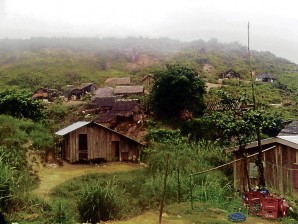Latest newcomer in remote gold-rush village: Electricity

THE MINING village of Dumagmang in Labo, Camarines Norte—which has grown into a gold rush area—had electricity for the first time on Dec. 12 last year. JONAS CABILES SOLTES
LABO, Camarines Norte—The gold rush mountain of Barangay Dumagmang in Labo, Camarines Norte, has attracted people from neighboring towns and provinces who are willing to risk life and limb for nuggets of gold.
Last month, a Johnny-come-lately—electricity—appeared, giving respite to diesel-powered electric generators which have roared over the misty village for years. It became the instant talk on the muddy streets.
Dumagmang is connected by a 14-kilometer dirt road to the Maharlika Highway and 35 km from the town proper of Labo or 50 km from Daet, the capital town.
Romeo Carilla, 36, was hauling heavy sacks of ores from an uphill pit when linemen from Camarines Norte Electric Cooperative (Canoreco) came for a last-minute check of power lines in the village below. Electricity would unburden small-scale miners like him, he said.
The monthly cost of electricity, Carilla said, should now be lower than the P6,000 he had to shell out to buy diesel to feed his generator at home every night.
Usually, residents start running their generator sets at dusk or at about 6 p.m. Lights go off at 10 p.m. To watch daytime television programs, they would run their sets at extra expense.
Dumagmang has a population of at least 1,600, mostly miners lured by the promise of finding gold by themselves without the financiers who have been lording over small-scale operations in neighboring Paracale town.
Despite the gold rush, mining in the village has not been lucrative, said Elizabeth Alvarez, 51, whose husband and three sons are all miners. Her family had relied on chipping ores from the hillsides, which, Alvarez said, is safer than digging a pit.
There are no other reliable sources of income for the family and many of the residents, she said. From mining, which demands a lot of hard work, the Alvarezes would just earn at most P10,000 a month. (Traders usually buy a gram of gold for P900.)
Rising pump prices of gasoline had cut drastically the monthly earnings of families who have generators for household use. Cost of diesel had tightened their budget for food and other basic commodities.
This had been the situation since the 1960s, so that when electric current first flowed in Dumagmang and the neighboring village of Exciban, villagers welcomed it like a most awaited friend.
The project was part of the rural electrification program initiated by the National Electrification Administration, Canoreco and the provincial government.
Dumagmang residents, however, were hoping that after the arrival of electricity, a large-scale mining company would not come next and take away the mining areas on which they have subsisted for so many years. It may not sit well with them that the town, in fact, is covered by a mineral-production sharing agreement of Mount Labo Exploration and Development Corp., the former El Dore Mining Corp.














